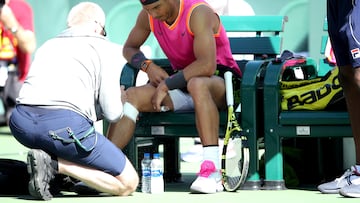What injury did Nadal suffer to his iliopsoas, where is it located, and how long has it kept him out of play?
This muscle, located between the abdomen and the front of the thigh, has been responsible for Nadal’s absence from the court on numerous occasions.

2023 was a challenging year for Rafa Nadal, as an injury sidelined him from major tournaments, including Roland Garros, where he’d been crowned king time and again, and which he missed for the first time in many years. Lingering discomfort and a slower-than-expected recovery forced him to take an extended break, and this injury, combined with other physical issues, has been one of the factors leading to his announcement of retirement from tennis. But what injury is it exactly that has plagued Nadal?
To understand the origin of the problem, we have to go back to January 2023, during the Australian Open. In a second-round match against American Mackenzie McDonald, Nadal suffered a Grade 2 injury to his iliopsoas, a muscle group that forced him to stop indefinitely, causing him to miss the entire clay court season, among other events.
How long was Nadal sidelined?
The initial prognosis was a six to eight-week recovery, with a treatment plan focused on rest and anti-inflammatory physiotherapy, according to a statement from Nadal’s team. However, the recovery process turned out to be more complicated than anticipated, and the Manacor native had to delay his return to the court multiple times.
In June 2023, Nadal underwent surgery, which extended his time away from the sport by another five months. In December, he announced plans to return to competition, but 2024 has seen limited action for Nadal, who was focused on getting into peak condition for the Paris Olympic Games.
What is the iliopsoas and where is it located?
The iliopsoas is composed of two parts: the iliacus muscle and the psoas muscle. Situated in the lower trunk, it connects to internal musculature near the last thoracic vertebra. It comprises the psoas major and psoas minor and is commonly referred to as the “muscle of the soul” because it is the deepest muscle in the human body.
Related stories
It’s important to note that it’s the only muscle of its kind that connects the spine to the legs, giving it significant functional importance. It plays a vital role in activities like walking or running, as it helps maintain stability in the spine and hips by controlling their articulation. Additionally, it’s involved in movements like hip flexion and lumbar spine flexion, making it a key component in overall body mechanics.
Translated using AI and edited by David Nelson
Complete your personal details to comment